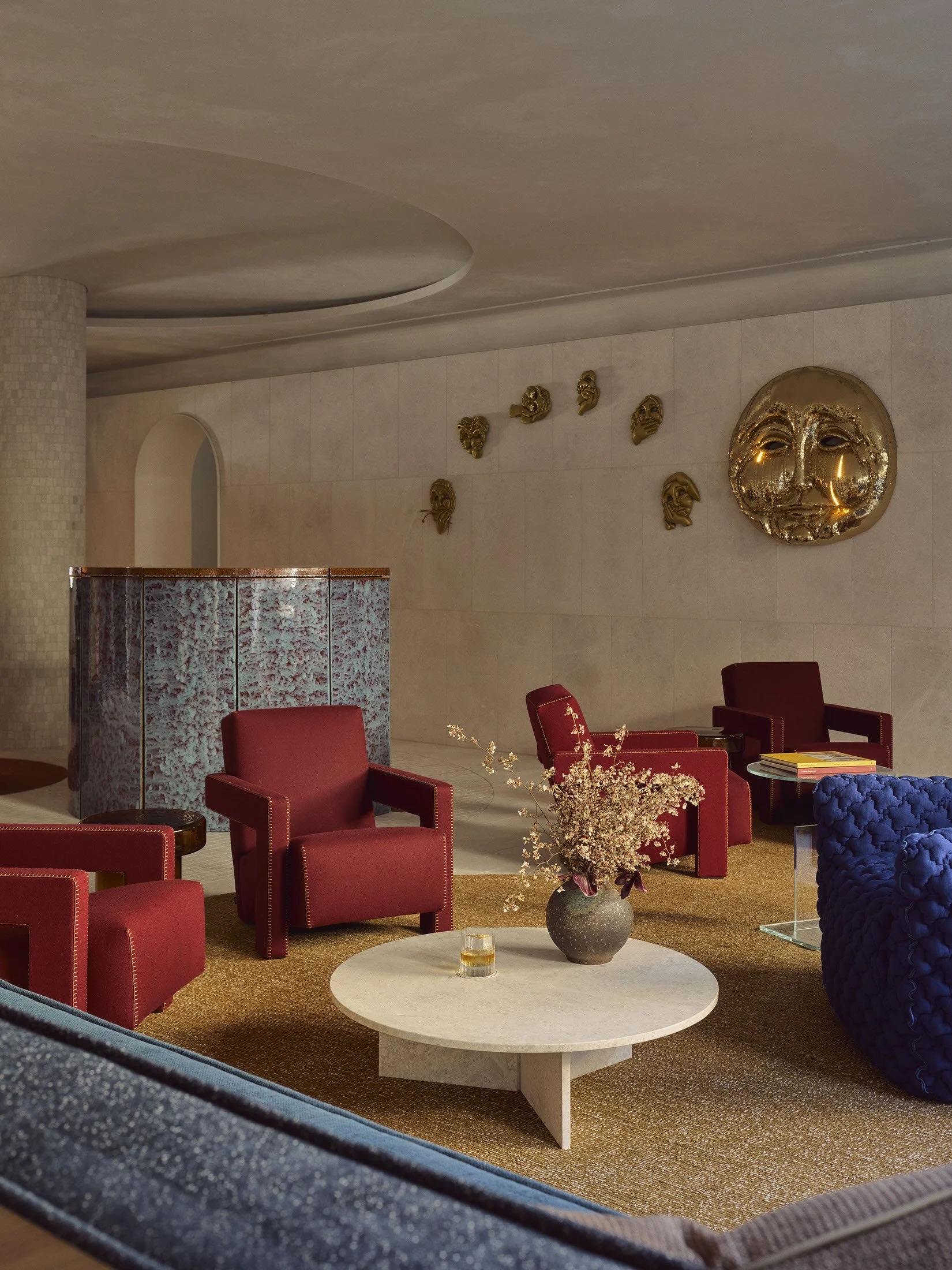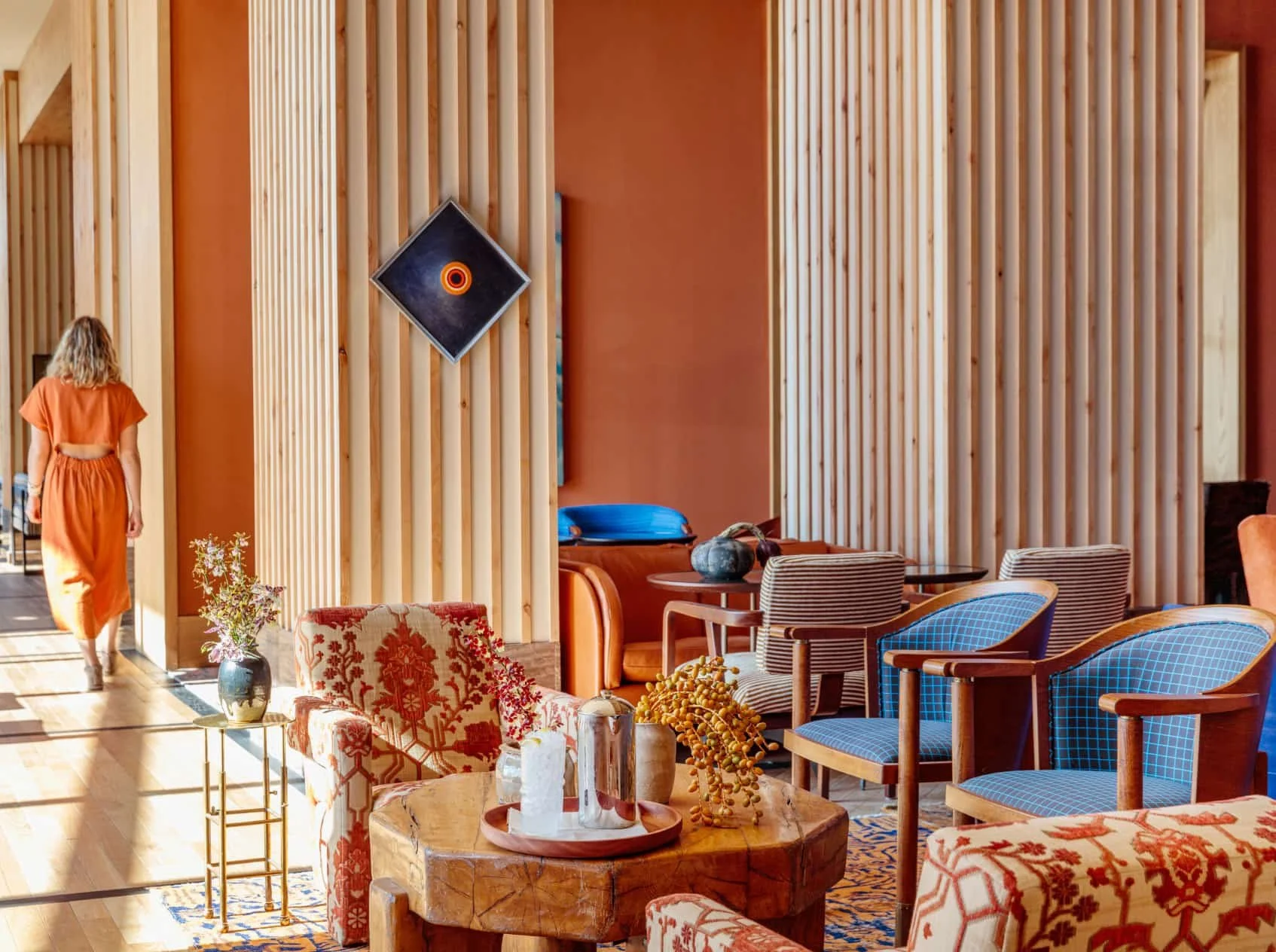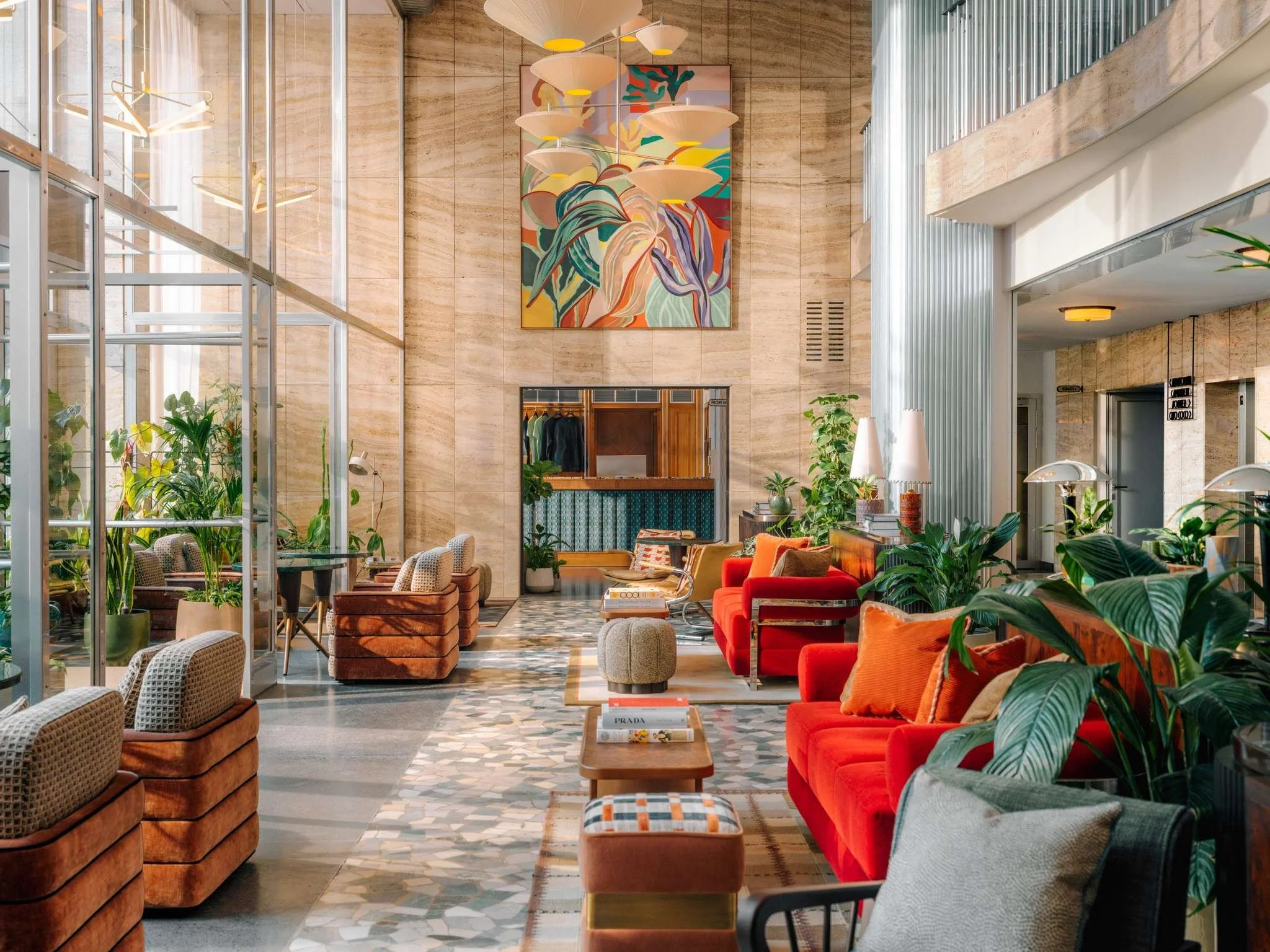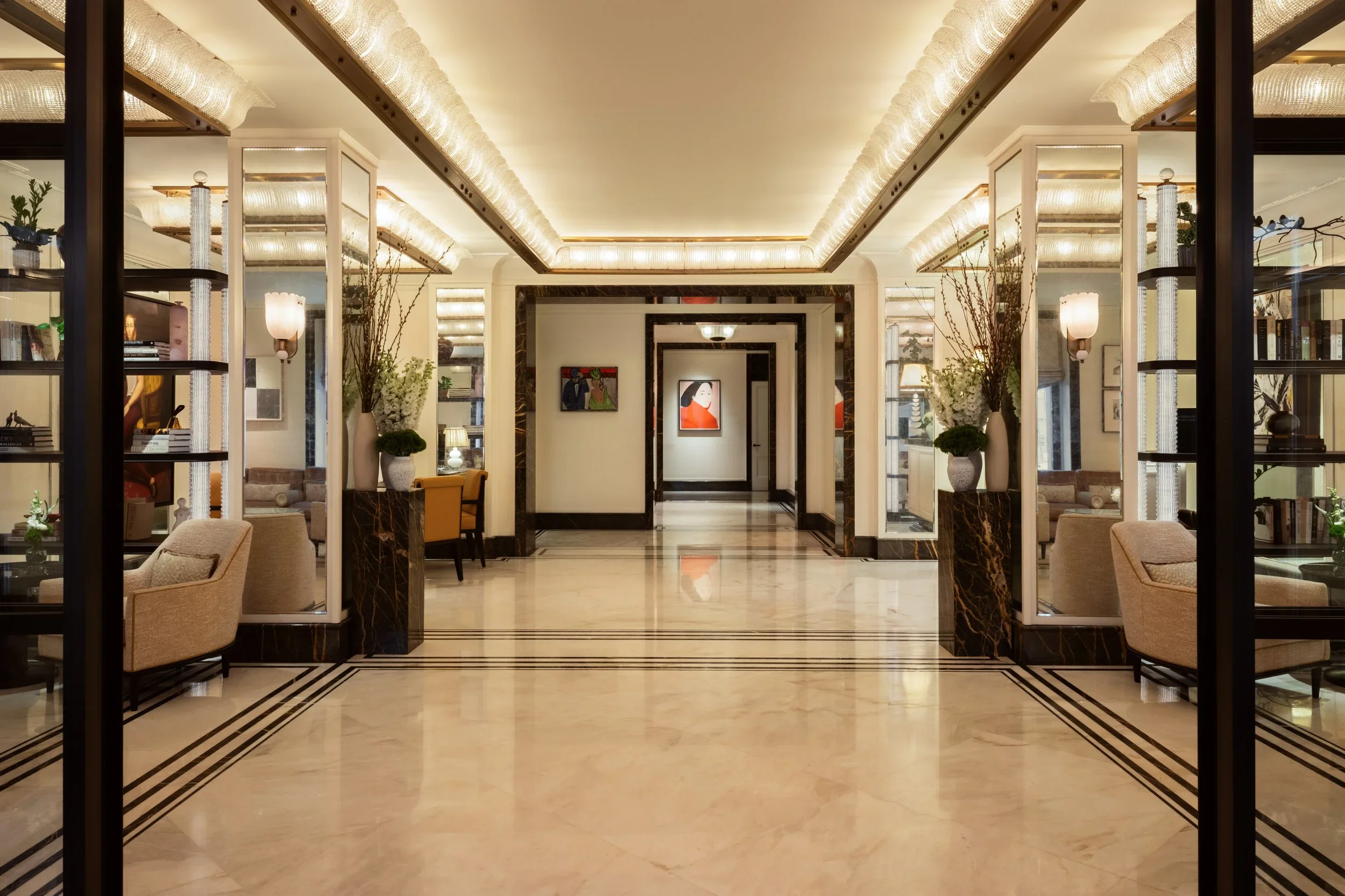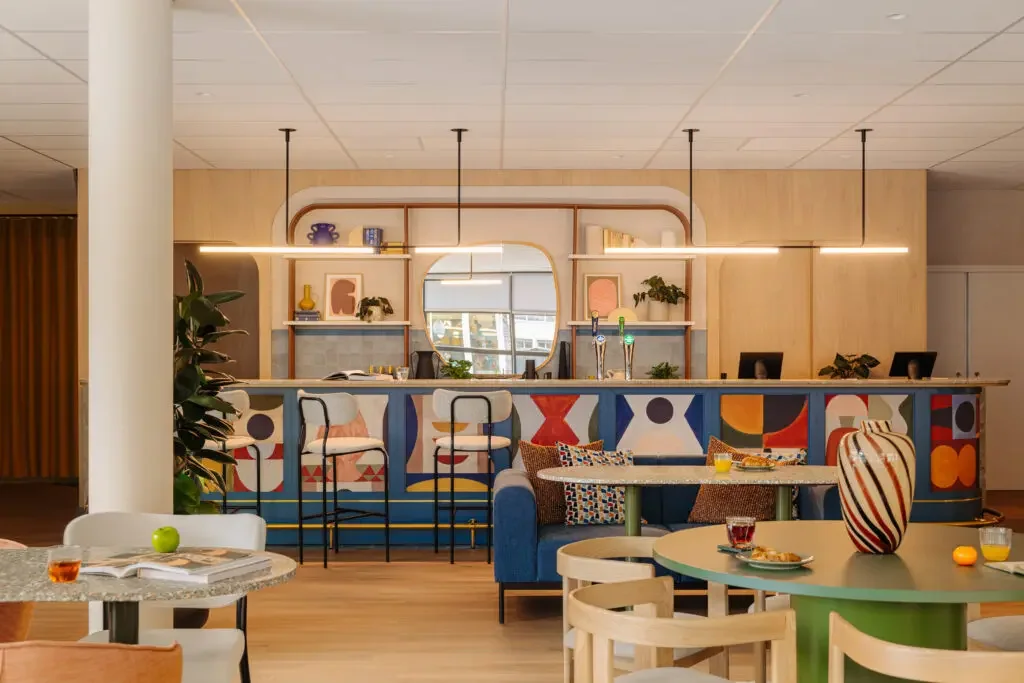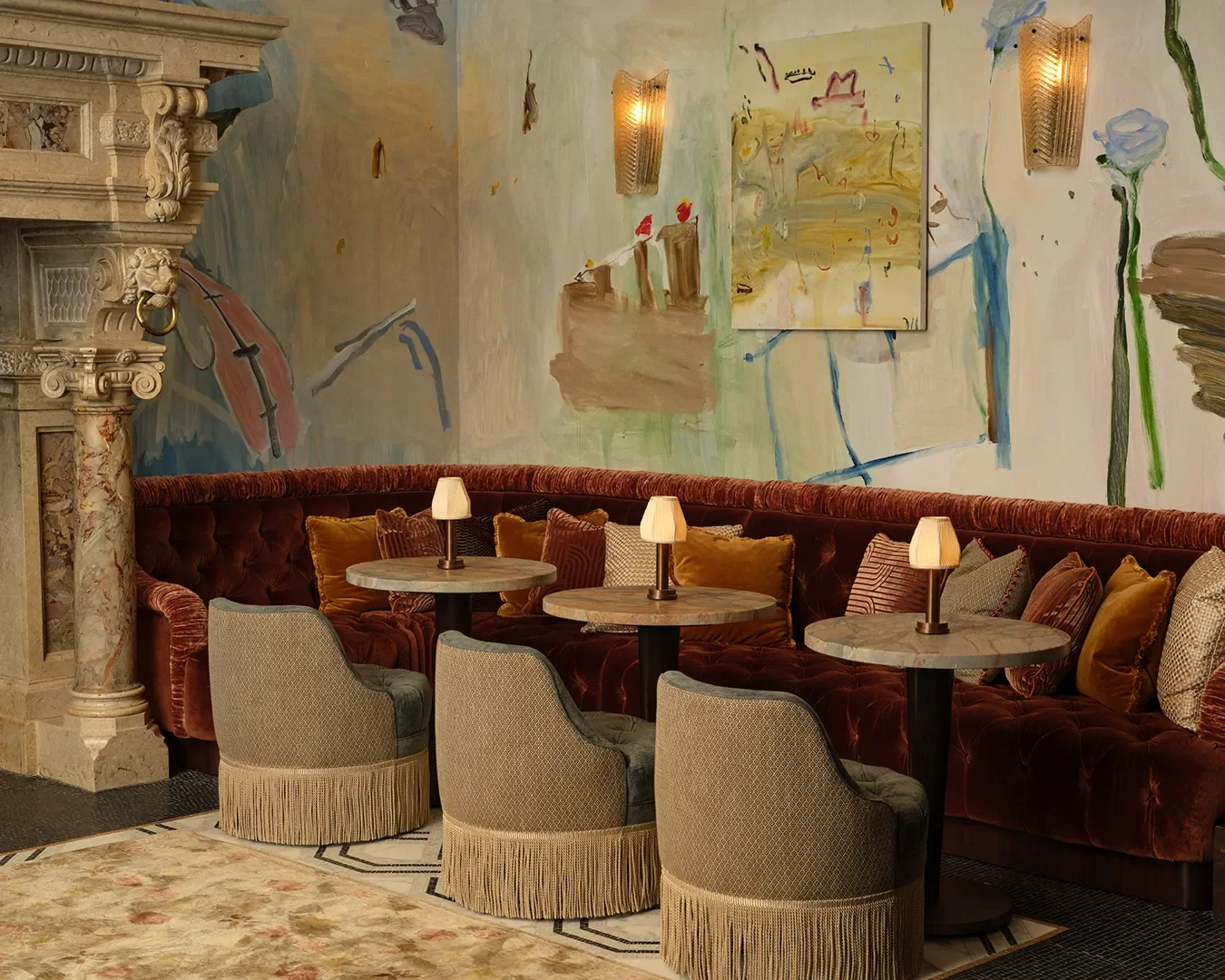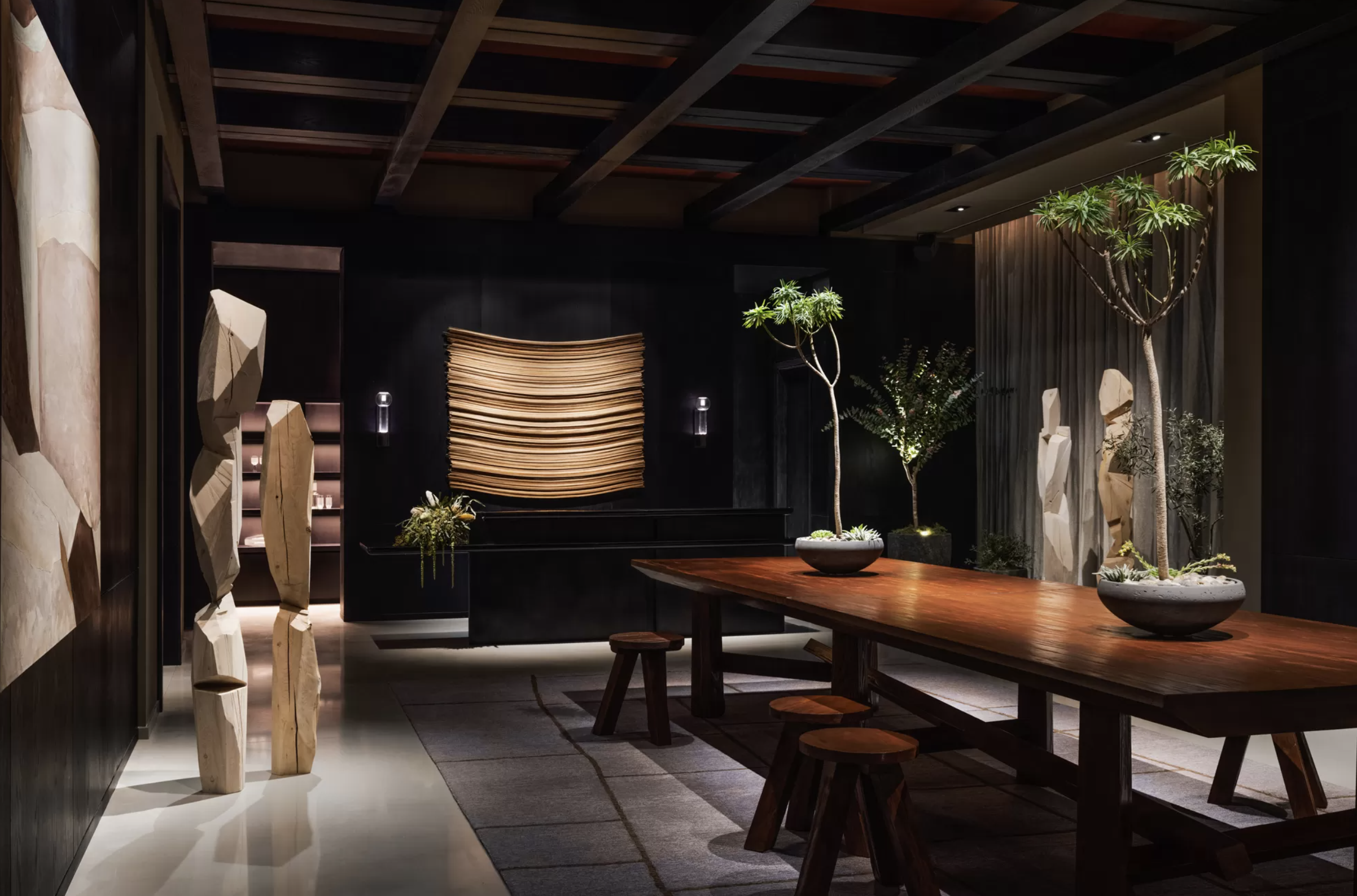The Complete Guide to Selecting Art for Luxury Hotel Lobbies
Selecting art for hotel lobbies and public spaces presents unique challenges that residential interior design projects simply don't face. You're designing for thousands of guests with diverse tastes, managing corporate brand standards, working within commercial art budgets and procurement timelines, and planning for maintenance requirements that span years, not months.
The lobby of a luxury hotel sets expectations, establishes brand identity, and creates the first emotional connection with guests who've chosen this property over countless others. Art is central to that narrative, it’s a critical design element that can transform a beautiful space into an unforgettable experience.
Whether you're working on a boutique hotel interior design project or a flagship property for an international luxury hospitality brand, this comprehensive guide draws on our own expertise of working on such projects and identifies what we see as the essential considerations for creating an exceptional hotel art program.
Please note: Selected images are not projects where we have worked as the art consultants, but are luxury hotel art programs that we admire and want to highlight.
The Eve Hotel, Sydney. Interior Design: SJB. Image Credit: Anson Smart
Decoding Brand Identity Through Art for Hotels
Every hotel brand has a personality, whether explicitly documented in brand standards or implicitly understood through their market positioning. Hotel art curation needs to reinforce that identity while allowing for local expression and uniqueness.
Established luxury hotel brands
It’s often requires that you work within detailed brand guidelines that specify everything from color palettes to the emotional tone the space should convey. Custom art for hotels needs to align with these parameters while still feeling fresh and specific to the property's location and architecture.
The key is understanding what the brand standards are really asking for. When guidelines call for "sophisticated" or "welcoming" or "energetic," translate those into concrete artistic qualities. Sophisticated might mean contemporary art with classical references and muted palettes. Welcoming could translate to accessible subject matter with warm tones. Energetic might call for bold abstracts with strong color and movement.Independent boutique hotels or luxury resort design projects
There is scope to have more creative freedom, but that comes with the responsibility of defining what the brand identity should be through your design choices. The hotel art collection becomes one of the primary tools for establishing the property's unique character and market position.
We often ask ourselves: Is this hotel positioning itself as a cultural destination? A serene retreat? An urban energy hub? A celebration of local heritage? Art for luxury hotels selections should answer that question consistently throughout the space.
Austin Proper Hotel. Interior Design: Kelly Wearstler
Designing for the Guest Journey in Hospitality Interior Design
Hotel lobbies serve multiple functions simultaneously, and your art program for hotels needs to work for all of them:
First Impression
The art guests see immediately upon entry sets the tone for their entire stay. This is your moment to deliver on the promise the hotel made through its marketing and booking experience. Choose pieces with immediate visual impact that communicate the property's character at a glance.
Circulation and Wayfinding
Strategic art placement can subtly guide guest movement through the space, create visual destinations, and make large lobbies feel more intimate and navigable. Significant works can draw guests deeper into the space or highlight key areas like seating zones or reception.
Dwell Time and Atmosphere
Guests spend time in lobbies waiting for companions, meeting colleagues, enjoying a coffee. Art creates visual interest that makes this time feel intentional rather than idle. Pieces near seating areas benefit from being able to reward longer viewing, with layers of detail or meaning that reveal themselves over time.
Social Media and Marketing
In today's luxury hospitality design landscape, lobby art often becomes one of the most photographed elements of the property. Work with your photographer's eye and consider how pieces will read in photos, what will become shareable moments, and how art can enhance the property's visual brand across digital channels.
Four Seasons Hotel Ritz, Lisbon. Interior Design: Henri Samuel. Image Credit: Richard Waite.
Cultural Sensitivity and Global Appeal in Hotel Art Curation
Luxury hotel guests come from everywhere. Your art selections for hospitality projects need to resonate across cultural backgrounds without defaulting to bland, universally acceptable work that sacrifices character for safety.
The solution isn't to avoid cultural specificity, but rather it's to embrace it thoughtfully. Art that celebrates local artists, regional traditions, or the property's specific location often resonates more strongly with international guests than generic contemporary work. Travelers seek authentic experiences, and art programs for luxury hotels that reflect genuine place-making often receive the strongest guest response.
That said, be mindful of:
Religious imagery that might alienate certain guest demographics
Political content that could create discomfort in shared spaces
Cultural symbols or motifs that might be misunderstood or appropriative
Subject matter that doesn't align with the hospitality context
The goal is work that feels distinctive and rooted in place while remaining welcoming to all guests.
Hoxton Hotel, Vienna. Interior Design: AIME Studios. Image Credit: Julius Hirtzberger
Art Placement Strategies for Maximum Impact
Visual Hierarchy:
The Anchor Piece for Hotel Lobbies
This is typically a large-scale work that guests encounter immediately or that dominates a key sightline. It sets the artistic tone for the entire program and often becomes the signature visual element of the property. For anchor pieces in hospitality interior design, consider scale that matches the architecture and work that can hold visual interest from multiple viewing distances.
Secondary Focal Points in Hotel Art Programs
These are significant works placed at important moments throughout the lobby, perhaps flanking the entrance, behind the reception desk, or in distinct seating zones. They support the anchor piece while creating visual variety and interest throughout the space.
Supporting Works for Hospitality Design
Smaller pieces or works in series that fill out the program, create rhythm, and allow for more experimental or intimate moments. These might include photography, works on paper, or smaller paintings that reward close viewing.
Height, Sightlines, and Architectural Integration:
Eye Level Isn't Always the Answer
While the standard 60-inch center height works for many residential applications, hotel lobbies often benefit from work hung higher to account for viewing distances and architectural scale. A piece that looks perfectly placed from across the lobby might feel awkwardly high when you're standing directly in front of it, and that's okay if most viewing happens from distance.
Architectural Elements as Opportunities
Don't fight the architecture! Columns can frame art or create natural gallery walls. Millwork niches are perfect for spotlit pieces. High walls can accommodate vertical compositions or stacked installations. Consider how art interacts with materiality; a sculptural piece against textured stone creates different energy than the same sculpture against smooth plaster.
Layering and Depth in Hospitality Art Consulting
Use art to create visual depth in the space. Pieces at varying distances from entry points keep the eye moving and make the space feel more dynamic. Consider how artwork visible from one area creates curiosity about spaces beyond.
Santa Monica Proper Hotel. Interior Design: Kelly Wearstler
Realistic Budget Allocation for Luxury Hotel Art Consulting
Art budgets for hotel lobbies vary dramatically based on property type, brand positioning, and overall project budget, but some general guidelines can help frame your planning:
Luxury Full-Service Hotels
Art budgets typically range from 1-3% of total construction budget, with flagship or brand-defining properties sometimes going higher. For a $30 million renovation, that's $300,000-$900,000 for the complete art program across the property, with a significant portion allocated to public spaces like the lobby.
Boutique Hotels and Luxury Boutique Hotel Interior Design
Often allocate 2-4% of construction budget to art, recognizing that unique art programs are a key differentiator in this market segment. The art becomes part of the marketing story.
Focused Service Hotels
Typically 0.5-1.5% of construction budget, with art programs focused on high-impact moments rather than comprehensive coverage.
Within your hotel lobby art budget, plan to allocate:
40-50% for the primary anchor piece or installation
30-40% for secondary focal points (2-4 significant works)
20-30% for supporting pieces, series works, and smaller moments
The Surrey, New York. Interior Design: Martin Brudnizki Design Studio
Artwork Types: Original Art vs. Art Reproductions
Hotel art programs often include a mix of acquisition strategies based on budget, timeline, and brand requirements:
Original Contemporary Art for Hotels
Provides authenticity, investment value, and unique character. Works best for anchor pieces and key focal points where distinctiveness matters most. Expect longer lead times (6-9 months) and higher per-piece costs, but stronger visual impact and marketing value for luxury hospitality projects.
Limited Edition Photography and Fine Art Prints
Offers contemporary feel at more accessible price points. Quality archival inkjet prints, photographic editions or what Print Club specializes in; limited edition handmade silkscreen prints, can provide sophisticated results, especially for supporting works in a comprehensive hospitality art program. Faster turnaround (8-16 weeks) and predictable pricing.
Commissioned Site-Specific Art for Luxury Hotels
Creates the most distinctive results and strongest brand storytelling, but requires longer lead times (6-12 months), clear creative direction, and experienced project management. Best for properties where art is central to the design concept and budget allows for this investment in hotel art consulting.
Curated Reproduction Programs for Hotel Chains
Some hotel brands use high-quality digital reproductions of museum works for consistency across properties. While less distinctive, this approach offers predictable results, shorter timelines, and centralized management. Most effective when customized with local touches rather than deployed identically across all properties.
The strongest hotel art programs typically combine approaches, investing in original or commissioned work for anchor moments while using editions or high-quality reproductions for supporting elements.
City Hotel Hengelo, Eden Hotel Group. Image Credit: Flare Department.
Procurement Timelines for Hotel Art Projects
Hotel project timelines are notoriously compressed, and art procurement for hotels often gets squeezed in the rush to opening. We find that the best way to protect your design vision is by building realistic timelines:
-
Finalize art program concept and budget for hotel interior design project
Identify potential artists for commissioned work
Begin gallery outreach for original pieces
Secure any required brand approvals
-
Commission contracts signed, artist begins work on custom hotel art
Specific pieces identified and placed on hold
Initial client presentations and approvals
Begin procurement for long-lead items (sculptures, large-scale works for hotel lobbies)
-
Commissioned work in progress, review meetings scheduled for hotel art projects
Purchase agreements finalized for original works
Edition prints ordered with proofs approved
Framing specifications confirmed for hotel art installation
-
Commissioned works completed and approved for luxury hotel projects
Original artworks delivered to secure storage
Installation plans coordinated with construction schedule
Lighting specifications finalized based on actual artwork
-
Art delivered to site as construction allows
Professional installation coordinated with final construction
Lighting adjusted for actual pieces in hotel lobby design
Final styling and positioning
The Golden Rule for Hotel Art Consulting:
Start earlier than you think necessary. The pieces you'll want won't be immediately available, and artists working on commission always require more time than they initially quote.
Downtown LA Proper Hotel. Interior Design: Kelly Wearstler, featuring a monumental custom commissioned ceramic wall mural by Los Angeles-based artist, Ben Mendansky.
Working with Galleries, Artists, and Art Consultants for Hotels
Different procurement sources offer different advantages for hospitality interior design projects:
Galleries
Provide access to established and emerging artists, typically offer hold periods for client consideration, and handle shipping and insurance. Expect 50% gallery commission on artwork, but you’ll benefit from their relationship with artists and quality assurance.
Direct from Artists
Can reduce costs on contemporary work and enable better communication about custom requirements or sizing. Requires more due diligence on contracts, shipping, and insurance. Works best when you have existing artist relationships or are working with emerging artists without gallery representation.
Art Consultants for Hotels
We may be biased but we always see the benefit in integrating the specialized knowledge of art consultants into hospitality projects. They have a clear sense of artists who would be appropriate for different hotel brands, they have established relationships with galleries and dealers, and experience managing complex procurement and installation for hotel art programs. Their fees (typically 15-25% of art budget) are offset by time savings, access to better pricing through established relationships, and risk mitigation.
For hotel projects and luxury hospitality interior design, working with an experienced art consultant for hotels often provides the best results. They understand hospitality requirements, can manage procurement timelines alongside construction schedules, and navigate the complexity of acquiring multiple pieces from various sources within compressed timeframes.
The Ned, NoMad. Interior Design: Soho House Design Team in collaboration with Stonehill Taylor
Maintenance and Environmental Considerations for Hotel Art
Hotel lobbies present environmental challenges that residential interior design spaces don’t typically face and art selections and placement for hotel art programs need to account for these realities. Lobbies in particular experience constant door openings, variable occupancy loads, and sometimes challenging climate control.
Choose media and materials that are appropriate for these conditions when curating artworks for luxury hotels:
Acrylic paintings
Tend to be more stable than oil in fluctuating conditionsWorks on paper
Require conservation framing with UV-protective glazingPhotography for hotels
Should use archival processes and protection from light exposureTextiles and fiber art
Are vulnerable to UV damage and need careful placement in hotel interiors. Fire codes may also require that they be treated with a fire retardant spray either before or after install.Sculpture for hotel lobbies
Ensure they’re fabricated using durable materials (bronze, stone, resin) which tolerate environmental variation better than delicate materialsMurals
Need their location to account for how much human interaction they’ll be exposed to, perhaps opt for ceiling murals or painting walls that are set back behind banquettes to limit the amount of wear.
Placement Strategies for Environmental Protection in Hotel Art Programs:
Avoid direct sunlight on any artwork—UV damage is cumulative and irreversible
Don't place valuable works directly above heat sources (fireplaces, radiators)
Keep art away from HVAC vents where temperature and humidity fluctuate
Consider indirect or dramatic lobby entrances where exterior doors open directly into the space
Plan for seasonal environmental changes—what works in winter might not in summer
Lighting Design for Longevity and Impact in Hotel Lobby Art
Lighting serves dual purposes in hotel lobby art programs, it can enhance the visual impact while also protecting the investment.
Illumination Best Practices for Hotel Art Installation:
LED Fixtures
Use only museum-quality LED sources with high CRI (90+) and color temperatures appropriate to the artwork (typically 2700-3000K for warmth, 3500-4000K for crisp contemporary work)UV Filtering for Hotel Art
Ensure all light sources, including natural light, have UV filtrationControlled Light Levels
Keep illumination at 150-300 lux for most artwork—enough to appreciate detail without causing damageDirectional Control
Use narrow beam angles for precise illumination without light spill that can cause glare or wash out the workDimming Capability
Program lighting to reduce intensity during low-occupancy periods, extending artwork life while maintaining ambiance
Maintenance Planning and Art Care for Hotel Art Programs
Hotel art endures far more exposure than residential work. Proactive maintenance planning protects your investment and keeps the lobby looking pristine.
Establish Maintenance Protocols for Hotel Art:
Regular Inspection Schedule
Monthly visual checks for any damage, shifting, or environmental issuesProfessional Cleaning for Hotel Art
Annual or semi-annual professional art cleaning, depending on location and exposureCondition Reports
Quarterly documentation with photos to track any changes over timeStaff Training for Hospitality Art Programs
Basic training for housekeeping on what not to do around artwork (never dust directly, never spray cleaners near art, report any issues immediately)
Common Maintenance Challenges in Hotel Lobby Environments:
Luggage impacts on works near circulation paths
Drink spills near bar or seating areas in hotel interiors
Fingerprints on sculpture or frames
Dust accumulation in textured works or on horizontal sculpture surfaces
UV damage from unchecked sun exposure in hotel art installations
Vibration from door closures or foot traffic affecting hanging hardware
Protection Strategies for Hotel Art Consulting:
Mount sculpture on plinths or in niches where luggage won't impact them
Use conservation glazing on all works near seating to protect from accidental contact
Install subtle barriers (planter boxes, furniture placement) to maintain viewing distance
Choose frames with sealed backs to prevent dust infiltration
Use professional-grade hanging hardware rated well above artwork weight
Create maintenance access plans—some pieces may need scaffolding or lifts for cleaning
Insurance and Documentation for Hotel Art Collections
Maintain detailed records of all artwork including purchase documentation, condition reports, professional appraisals, and high-quality photography. Ensure property insurance covers the full replacement value of the art program, and review coverage annually.
AC Hotel, Downtown LA. Interior Design: Yabu Pushelberg
The Art of Hotel Art Consulting
Selecting art for luxury hotel lobbies requires balancing creative vision with practical realities, brand requirements with local character, and immediate visual impact with long-term durability. It's a specialized discipline that sits at the intersection of interior design, art market knowledge, hospitality understanding, and project management.
The most successful hotel art programs for luxury hospitality projects share common characteristics:
Strong conceptual foundation aligned with brand identity and location
Clear visual hierarchy with impactful anchor pieces
Thoughtful integration with architecture and design
Realistic budgets and timelines built into project planning from the start
Environmental and maintenance considerations addressed proactively
Expert guidance from art consultants for hotels who understand both art and hospitality
Whether you're designing your first hotel lobby or your fiftieth boutique hotel interior design project, approaching the art program with this comprehensive framework ensures results that enhance the guest experience, strengthen brand identity, and stand the test of time.

